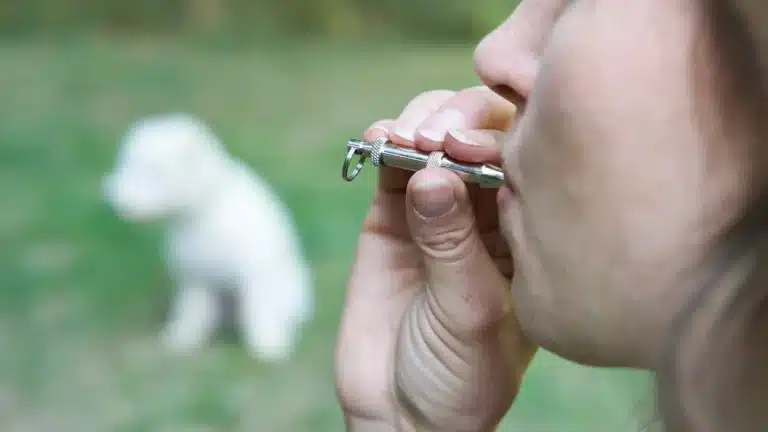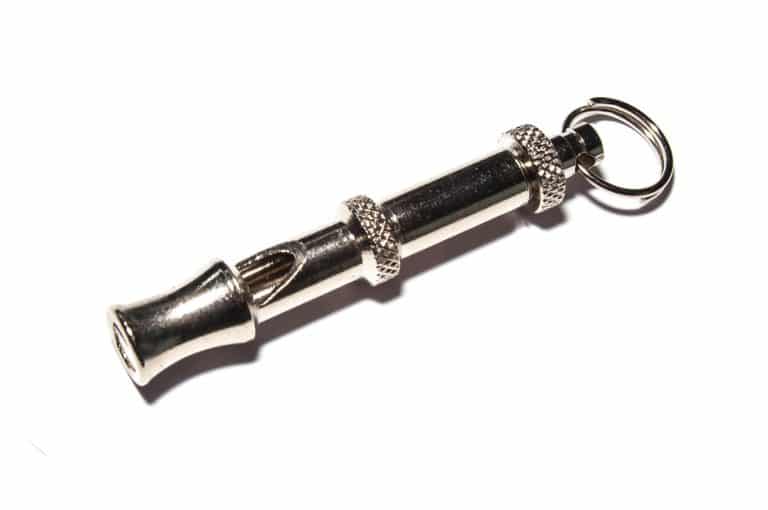How to Use a Dog Whistles for Training Effectively
- Anja Boecker
- Updated: 2023-12-07
Are you tired of yelling at your dog to come back to you? Tired of passersby staring at you as you desperately try to call your dog? Then a dog whistle is for you!

Dog whistles are a classic but often underestimated tool in every dog trainer's arsenal. In this article, we will find out why the dog whistle is much more than just a tool and how to use it effectively when training your four-legged friend.
For centuries, dog handlers have used whistles to communicate with their dogs over long distances. The unique ability of the dog whistle to produce a unique and consistent signal that is clear and distinct to the dog's ears makes it an indispensable tool.
We will introduce you to different types of dog whistles, show you how to use basic and advanced training techniques and give you valuable tips on how to avoid common mistakes.
Whether you're a new dog owner or looking to improve your existing training techniques, the dog whistle is an exciting way to improve communication with your dog and take your training to the next level.
Do you want to use a dog whistle and know all about it? Then you need to do some training with your dog. He must be able to distinguish the sound of your dog whistle from other noise
Learn exactly how to do this and how to choose the right pipe in this guide.
Why a Dog Whistle?

Many dog owners are distraught when their furry friends follow their hunting instincts in the park. In addition, many owners are ashamed to shout loudly behind their pet. This not only disturbs those around them, but also conveys fear, desperation, or anger to your faithful companion.
Plus, not everyone has a voice loud enough for their pet to hear. You can call your furry friend directly with a practiced whistle. Of course, he has to know the whistle and what it means.
By the way, horn instruments are of very high quality. They produce a simple, bright sound and provide many years of valuable service.
- A dog whistle is a very high-quality instrument.
- You can use the whistle in everyday life
- Your loyal friend will follow you.
The best thing about the dog whistle is that it always sounds the same. It produces a neutral tone. Your friend will always respond to this signal. You just need to train him to understand the tone of the signal.
Your puppy needs to learn what the whistle means. He also needs to learn what you are trying to accomplish with the whistle. After all, the sound is supposed to trigger a reflex in him. It doesn't matter if he's barking or playing. When you whistle, he will stop everything and come to you. Then you should reward him with a treat.
Species
Dog whistles are a fascinating and versatile training tool. They come in a variety of shapes and sizes, each with its own unique characteristics. Let's take a look at the different types of dog whistles and understand why they are so effective in training.
- Standard pipes: They are available in a variety of frequencies and are well suited for general obedience training.
- Ultrasonic whistles: They produce a sound at a frequency that is barely audible to the human ear, but very clear to the dog. They are ideal for training in noisy environments.
- Silent pipes: Despite their name, these whistles produce a sound that is almost inaudible to humans. They are often used in hunting training because the sound can be heard over long distances without disturbing the game.
Dog Whistle Texture & Function

Dog whistles use high frequencies that are particularly easy for dogs to hear. These frequencies penetrate noise and distance better than the human voice.
This makes it an ideal means of communication, especially in situations where the dog is out of sight. A dog whistle produces a constant and neutral tone.
You can use it when your pet is far away from you. If you are walking in the woods without a leash, you will especially benefit from this device.
Basically, you can use a dog whistle to call your dog back in any situation. It is actually an ordinary whistle. It is just slightly modified to meet the needs of pet owners.
The devices are usually frequency normalized. This means that the sound is always the same. For the animal this means that the best possible training effect is achieved.
It doesn't matter whether the master, mistress or child operates the device.
Most of these products come with a carrying strap. So you can easily take them with you. The whistle is always at hand. They are also available in fashionable and neutral colors.
Dog whistles are made from a variety of materials including plastic, metal and natural materials such as wood or horn. Plastic models are very weather resistant. Metal products are very sturdy in comparison.
However, they are susceptible to rust and are heavier. Models made of natural materials are usually artistically designed. They are also environmentally friendly. Wood can also swell quickly when exposed to moisture.
Most manufacturers offer standardized or standardized models. This means that you can buy several of the same type and your dog will always hear the same sound. This way you will have consistent training success.
Here are the pros and cons of a dog whistle:
| Advantages & Benefits | Disadvantages |
|---|---|
|
|
|
What You Need to Know About the Frequency of a Dog Whistle
Every manufacturer uses a different frequency. This is important because not every pet responds to every frequency. It is best to try one or two models and then choose one. Basically, you should always test which model your own pet responds best to.
Some dog whistles are also available as ultrasonic whistles. These are models where people cannot hear the sound. This means that your neighbors or other people in the area will not be disturbed.
There are also adjustable frequency models. For example, you can train two dogs at different frequencies. If you want a silent or quiet version, you will need to choose a very high frequency. The higher the frequency, the harder it is to hear the dog.
Training With a Dog Whistle

This training requires a lot of patience. Your pet should only be given special treats in conjunction with the whistle. He will see it as an opportunity to get bonus treats.
He associates the whistle with something good. He will be happy to respond to the whistle and run back to you. This reflex is called operant conditioning.
You should conduct the first training sessions when your protégé is in close proximity. He should not be distracted at this time. Now you must whistle and change direction. After a short time, your faithful companion will recognize the call of the whistle and sprint back to you.
When he arrives, reward him with a treat. After two or three days, just repeat the game. He will learn that if he hears the beep and comes your way, he will always get something special.
However, you should reduce the reward after a while. For one thing, it might get too fat. On the other hand, you may not have a special treat with you in every situation. The following approach has worked well in training:
Step 1
You should use the device at home for at least ten days. This is because there are very few distractions. You should also only use the whistle before playing together, before eating or before going for a walk.
In the beginning, it is important that the sound is not too loud. Your pet may become frightened or perceive the sound as something negative. This can affect the success of the training. It is better to start the training gently.
Step 2
Once you have completed the first phase and have trained your dog in your home for at least 10 days, you will move on to the second phase, which also lasts 10 days. During this phase, it is advisable to enlist the help of another person. This could be your friend, your partner, or your child.
This person should keep your pet in another room. This will prevent it from immediately running after its owner. Now pick up the dog whistle and whistle. The helper will now let go of your pet so that it can run to you immediately. If your pet makes it, you should reward him.
This could be a chew bone or a treat. It depends on your furry friend's individual preferences.
Step 3
Once you have completed the first two phases, take your dog outside. Again, make sure he is not distracted. You should continue to keep him on a leash.
Now take him for a walk and as soon as he looks into your eyes, whistle. He should react and come to you. Then reward him. Again, this should be done without distractions. Phase 3 also takes 10 days.
Advanced Exercises
The basic exercises should take about a month. Your dog should now be able to hear the whistle in distraction-free situations. He now knows what the whistle means and what you want him to do.
Now you should do some exercises that are a little more difficult. For example, you can hide in the apartment or house so that your furry friend has to look for you.
If there are no distractions outside or in the park, you can whistle without a leash. You can also slowly increase the distraction, but only a little at a time. However, he must already respond perfectly without distraction.
You can also train him over longer distances, such as in the woods. Finally, you can train him with other dogs in the immediate area. It is important that you always reward your dog. He needs a lot of reassurance to come back to you later without a reward.
However, this does not mean that you should stop rewarding him later on. A few treats every now and then will keep him motivated to obey your commands. Finally, you should always whistle again after training.
Your dog should not always think about being on the leash when you whistle. Instead, he should come to you from time to time to get his reward. This will increase his motivation to respond to your needs.
9 Tips & Tricks
Two things are essential when training with a dog whistle: consistency and patience. These two factors are key to success and will help you and your dog avoid frustration and achieve positive results. Let's take a look at how you can apply these principles to your training.
1. Standardized Signals
Always use the same whistle signal for a particular command. This will help your dog understand and respond to commands more quickly.
2. Regular Training
Conduct training sessions regularly. A consistent routine gives your dog structure and security.
3. Clear Expectations
Be consistent with your expectations and feedback. This avoids confusion and builds your dog's trust in you as a trainer.
4. Accept the Individual Learning Pace
Every dog learns differently. Accept your dog's individual learning pace and set realistic goals.
5. Create a Positive Environment
Keep the training as positive and stress-free as possible. This will increase your dog's willingness to learn.
6. View Setbacks as Part of the Process
Not every day will be perfect. View setbacks as a normal part of the learning process and use them as opportunities for growth.
7. Self-Reflection
Review your own training methods regularly and adjust them as needed.
8. Take Breaks
If you or your dog get frustrated, take a break. A short walk or play break can work wonders.
9. Celebrate Successes
Recognize and celebrate progress, no matter how small. This builds motivation and connection.
Common Mistakes When Training With the Dog Whistle
The dog whistle is a powerful training tool, but only when used correctly. As with any training method, there are typical pitfalls that dog owners can fall into. Let's examine some of these common mistakes and find out how to avoid and correct them.
#1 Inconsistent Use of the Whistle
- Error: Using different whistle signals for the same command or using the whistle inconsistently can confuse your dog.
- Correction: Choose a specific whistle signal for each command and use it consistently.
#2. Excessive or Inappropriate Use
- Error: Whistling too often or in inappropriate situations may cause your dog to ignore the signal.
- Correction: Use the whistle selectively and only when necessary. Avoid using the whistle as a substitute for clear communication or education.
#3. Lack of Positive Reinforcement
- Error: Use of the whistle without positive reinforcement may result in the dog not being motivated to respond.
- Correction: Always combine the whistle signal with a reward or praise to encourage a positive association.
Important Do's and Don'ts
| Do's | Don'ts |
|---|---|
|
|
The Most Popular Dog Whistles
Choosing the "best" dog whistle depends largely on the individual needs of the dog and the trainer. However, there are some popular and widely used brands and models that are valued by many dog trainers and owners for their quality, reliability and effectiveness. Below are some of the most commonly recommended options:
Acme 210.5 and 211.5
These two Acme models are popular for their consistent quality and ability to produce a clear, penetrating tone that can be heard over long distances. They are easy to use and are well suited for general training and callbacks.
Fox 40 Classic
Known for their extremely loud and clear sound, Fox 40 whistles are especially popular with dog owners who train in noisy environments or over long distances.
Silent Whistle
Mute or silent whistles, often called shepherd whistles, are adjustable and can produce a sound that is audible to the dog but almost imperceptible to the human. They require practice, but offer flexibility in tone frequency.
Clix-Whistle
A good option for training in urban or densely populated areas. It produces a clear sound that is easy for the dog to hear, but not too intrusive to the environment.
When purchasing a dog whistle, you should consider the following factors:
- Sound frequency and volume: Depending on your training needs and the environment in which you train.
- Material and durability: High-quality materials ensure long service life.
- Ease of use and comfort: The whistle should be comfortable to use and wear.
- Individual dog preferences: Some dogs respond better to certain frequencies or sounds.
It is advisable to try different models and see how your dog reacts to them before making a final decision. In the end, the "best" dog whistle is the one that works best for you and your dog.
Which Dog Whistle to Use for Recall
Special dog whistles known as "recall whistles" or "training whistles" are often used to recall a dog. These whistles are designed to give a clear, consistent signal that the dog can hear over long distances or in noisy environments. The most common types are
Acme Whistles
A very popular brand of dog whistle. The Acme 210.5 and 211.5 are two models often used for recall training. They produce a clear, penetrating sound that the dog can hear from a great distance.
Ultrasonic Whistle
They produce a high-pitched sound that is barely audible to the human ear, but very clear to the dog. They are especially useful in noisy environments because the sound stands out from the background noise.
Silent Whistles
They produce a sound that is almost inaudible to humans, but audible to dogs over long distances. They often require some practice, but offer a wide range of customizable sounds.
The following factors should be considered when choosing a recall dog whistle:
- Range: The whistle should produce a sound that is audible at the distance you want to call your dog.
- Uniformity: Choose a whistle that produces a consistent tone so that the dog learns and recognizes the signal more quickly.
- Comfort and ease of use: The whistle should be comfortable to wear and easy to use.
It is important that the whistle be used as part of a comprehensive training program in which the dog learns to respond to the whistle signal by returning to its owner. This is usually accomplished through a combination of positive reinforcement and repeated practice.
Is a Dog Whistle Painful for the Dog?
A dog whistle in itself is not normally painful to a dog. These whistles are designed to produce a high frequency sound that is easily audible to dogs, but not normally painful.
In fact, the tone of most dog whistles is in a range that will get the dog's attention without causing discomfort. However, there are some important points to keep in mind:
Very loud noises or extremely high frequencies can cause discomfort for some dogs. It is important to use the whistle at an appropriate volume.
As with humans, there are individual differences in canine hearing. Some dogs may be more sensitive to certain frequencies. Observe your dog the first time you use the whistle to make sure he does not become anxious or stressed.
The whistle should be used as part of a positive training approach, not as a means to frighten or punish the dog. The sound of the whistle should be used as a signal for a command or reward, not as a noise to frighten the dog.
In general, when used correctly and responsibly, a dog whistle is a safe and effective way to communicate with your dog. However, if you are not sure how your dog will respond to the whistle, it is advisable to consult a professional dog trainer or behaviorist.
Frequently Asked Questions
Here is a list of manufacturers and brands:
- Rusty Bob
- WellPets
- ACME Whistles
- Herbertz
- Villkin
- PetPäl
- YHmall
- Faburo
Stiftung Warentest has not yet tested dog whistles. We have not found anything on this subject in Germany.
If you want to see if whistling is right for your furry nose. You can download an app with different whistle sounds.
The dog whistle always makes the same sound when you blow into it. This is usually at such a high frequency that only dogs can hear it. You can train your dog to come to you when he hears the dog whistle.
The cost of a dog whistle can vary from about 3 to 20 Euros. Our recommendation is about 15 Euros. For this relatively low price you get a good and durable product.
Unlike the human voice, which can change depending on emotion and situation, the dog whistle gives a consistent signal. This makes it easier for your dog to learn and follow commands. The clear signals of the dog whistle minimize confusion and promote quick learning. The sound of a dog whistle can be heard over long distances, making it ideal for outdoor training.
Yes, there are dog whistles that are integrated into a bracelet. This type of design offers practical advantages as the trainer or dog owner can always have the whistle at hand. A dog whistle bracelet is especially useful in situations where you need to access the whistle quickly without having to hold it in your hand or fumble around in your pocket.
These bracelets are usually designed so that the whistle is securely attached to the bracelet and can be easily removed and used when needed. They are often made of durable materials such as nylon or leather and come in a variety of colors and designs.
When purchasing a dog whistle bracelet, it is important to pay attention to the quality of both the bracelet and the whistle. A well-made whistle and a sturdy bracelet will ensure longevity and reliability during training.
Video & Conclusion
After delving into the world of dog whistles, it has become clear that they are more than just training aids. Dog whistles are important tools for communicating effectively with your dog over long distances and in different environments.
Whether you are a beginner or an experienced dog owner, the proper use of a dog whistle can greatly enhance your training and relationship with your dog.
Remember that choosing the right whistle is just as important as how you use it. Consistency in your signaling and combining it with positive reinforcement is critical for your dog to quickly understand and respond to the whistle. Practice regularly, be patient, and celebrate small successes along the way.
It's not just about training your dog, it's about building a bridge of communication based on trust and understanding. A dog whistle is a powerful tool that, when used correctly, allows for clear and effective communication between you and your four-legged friend.
A dog whistle is an inexpensive purchase that can help you train your dog. It takes the strain off your voice and can work wonders.
However, it takes a lot of patience and special training with the whistle for you and your pet to really benefit from it. But for the low price and effort, the dog whistle can really be worth the purchase.

My name is Anja Boecker, and I am a certified dog trainer and behavior consultant. With these articles, I want to help you to understand your dog better and to build an inseparable bond.
Share Now:


Hello dear Anja,
Even if I think I already know everything, I still like to look at reports from other animal lovers. Of course, I agree on the whole with your report and find this fully successful, but my methods differ from yours massively. You yourself write about bonus rewards and the crux with the weaning. There the cat bites itself in the tail which means that a permanent regression takes place. I work on the main food, the dog works out that food in the game and from the beginning under small distraction maneuvers. I look for an area where no two and four-legged friends are (in Havelland no problem) and attach the dog in the harness with a drag line to a tree, to a branch that is flexible and yields. So, now we have breakfast, I run backwards and whistle main food, whistle main food, whistle main food, about 5 minutes, then the leash off, whistle play, whistle play, rumtollen hide, now there is again a little main food and we go for a walk.The whole thing you keep about 10 days, then you repeat that procedure, but now you change some, change direction with long whistles, about 10 days. Then 10 days on the drag line through the forest, the drag line may only serve as a boundary, never pull the dog back and then try to correct a mistake and do not forget we work now again with short whistles.Your dog has now internalized the command, the social bond is strengthened and so that this a second whistle with the same frequency and whistling technique is filtered out and ignored by his selective hearing. And above all, you no longer have to wean him off anything, this dog is now in fact your best friend.
With kind regards
Dear Ralf, thank you very much for your detailed description of your method. It is great to see how different approaches can lead to the same goal. Using the main food as a reward in play and gradually increasing the distractions sound effective and patient. Gradually integrating direction changes and solidifying the social bond are certainly important steps. It's remarkable how your dog has internalized whistle signals so well. There are indeed many ways to build a close bond and trust between human and dog. Every dog is unique, and it is inspiring to see how you have trained your best friend in this way.